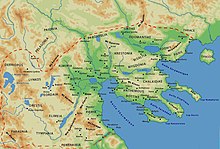Upper Macedonia
Upper Macedonia ( ancient Greek ἄνω Μακεδονία anō Makedonía ; also Upper Macedonia ) is a geographical term that is used to describe the mountainous landscapes of ancient Macedonia . Before Strabo , this term was used as early as the 5th century BC. Used by Herodotus for his description of the founding legend of the Macedonian kingdom. The area in question was roughly congruent with the present-day Greek region of West Macedonia and also comprised some areas in the south of what is now the Republic of North Macedonia .
The southern border of Upper Macedonia was formed by the Aliakmonas river , with Thessaly in the southeast and Epiros in the southwest . In antiquity the tribes of the Illyrians bordered to the west and northwest and the land of the Paionians to the north . The slopes of the Bermion (Vermio) sloping down to the east joined the Lower Macedonian Plain .
Upper Macedonia included the landscapes of Elimiotis , Orestis , Lynkestis , Pelagonia and Eordaia . Furthermore, Tymphaia , Parauaia , Perrhaibia and Dessaretia are also included, which, however, were not Macedonian settlement areas and were only conquered for the kingdom by Philip II . According to Thucydides , the Macedonian people had their original seats in the mountains of Elimiotis and Lynkestis, from where they expanded eastwards from around the 12th century BC to the more fertile Netherlands on the Thermaic Gulf . While a monarchical state was established there under the leadership of the Argeades , which sought connection to the Hellenic culture, the parts of the population remaining in the mountain regions retained an archaic tribal structure for a long time, with a low degree of urban culture. The landscapes were ruled by their own royal houses, which were either loosely dependent on the Macedonian kingdom or fought against it for their independence. Often they were threatened by incursions from the Illyrians to the northwest.
Only King Philip II was able to manage Upper Macedonia in the middle of the 4th century BC To the direct rule of kingship. Under his rule, a more extensive urbanization began here , with the establishment of cities such as Herakleia Lynkestis . Members of the royal houses were now brought up at the royal court in Pella , where they also had to vouch for the loyalty of their families as hostages. Some of them became well-known companions of Alexander the Great . In his army three battalions of the Pezhetairoi were assembled from warriors of the upper Macedonia, who were led by members of their tribe.
literature
- Fritz Geyer: Macedonia up to Philip II's accession to the throne. In: Historische Zeitschrift , Vol. 30 (1930), pp. 1–148.
- AB Bosworth: Philip II and Upper Macedonia , In: The Classical Quarterly , Vol. 21 (1971), pp. 93-105.
- Joseph Roisman and Ian Worthington: A Companion to Ancient Macedonia (Blackwell Publishing Ltd., 2010)
